| omiš | split | salona | trogir | np krka | imotski | dubrovnik |
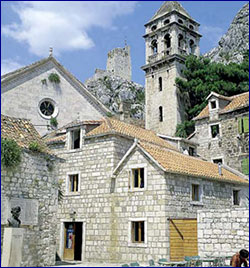
Omiš, the town of contrasts, both - natural and historical. It was founded and grown on the steep slopes of Omis Dinara mountain, surrounded by the Cetina River in the north-west, and the sea in the south and south-east. It has grown as suburbia (burgum, suburbiam) of Omis castle (castrum) built high above, on the hill. Due to permanent threats from the land, as well as from the sea, the existing castle “Starigrad” (Fortica), with military crew in it, and supporting tower “Visec” in Cetina River canyon, were not enough for town defence, so, already in Middle Ages, Omis was encircled by walls, fortified with strongholds on the eastern land side, and fortress “Peovica” (Mirabella) on the north-western side. Only when it was surrounded and fortified by walls it became “town”, but not in the true sense of the word, as for that it should have been Bishop residence, and that never happened. Medieval town was named Olmissium, Almyssium, and later, under Venetian’s rule Almissa.
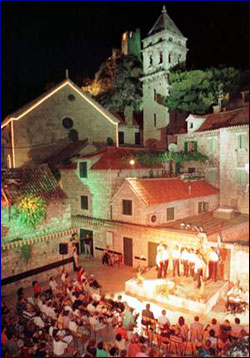
Culture: Starting from the cultural past, we will find that neither the old town walls nor the narrow streets were ever obstacle in acceptance and promotion of modern ideas. During dynamic passing of the centuries, Omis has been enriching its cultural life according to immediate possibilities and financial situation.
Today, the main happening of Omis Cultural Summer is “Festival dalmatinskih klapa” (Festival of Dalmatian folk songs), which is being held, on regular basis, every year since 1967. It helped in cherishing and keeping alive the tradition of folk singing, which is praised all over the Europe. This is based on a capella singing, and the lyrics bear witness to hard life of Dalmatian fishermen and peasants. Omis Cultural Summer has been enriched with concerts and recitals in churches and in the Closter of Franciscans Monastery, as well as performances on the squares, exhibitions and literary and music happenings.

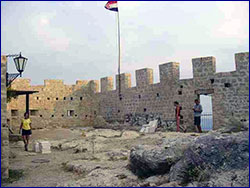
The fortresses Mirabella and Fortica, which are well preserved until now-days, bear witness to the pirate history of the town. It is possible to see the whole town of Omis from Mirabella, and from Fortica you can see islands of Brac, Hvar, Šolta, as well as Middle Poljica and the mouth of Cetina River.There are 8 churches in Omis: church of Sv.Mihovil (St. Michael), Sv.Duh (Holy Ghost), Sv.Rok (St. Rock), Sv.Petar (St. Peter), Sv.Luka (St. Luca church), St.Mary church and Franciscan Monastery with church of Gospe od Karmela (Our Lady of Carmel), church of Sv.Stjepana (St. Stephan’s) and remains of Sv.Ivan church (St. John’s) in Borak. Also There is a famous legend about Poljica’s heroine Mila Gojsalic, who, with help of Poljica people, managed to defeat Turks. She was perpetuated by many Croatian artists, among them is famous Ivan Meštrovic, whose sculpture decorates the position in Poljica with unforgettable view over town of Omis.
| top |

The town Split is situated in the middle of the Adriatic cost, near rivers Jadro and Žrnovnica which gives him water for 1700 years.
Split is famous after his monuments which I recommend you to see.

Many of Split's historical and cultural buildings can be found within the walls of Diocletian's Palace. In addition, numerous museums, the National Theatre, and old churches and other archeological sites in the Split region make it an important cultural attraction.
At the end of the third century AD, the Roman Emperor Diocletian built his palace on the bay of Aspalathos. Here, after abdicating on the first of May in A.D. 305, he spent the last years of his life. The bay is located on the south side of a short peninsula running out from the Dalmatian coast into the Adriatic, four miles from the site of Salona, the capital of the Roman province of Dalmatia. The terrain on which the palace was built slopes gently seaward. It is typical karst terrain, consisting of low limestone ridges running east to west with marl in the clefts between them. This palace is today the heart of the inner-city of Split where all the most important historical buildings can be found. The importance of Diocletian's Palace far transcends local significance because of its level of preservation and the buildings of succeeding historical periods, stretching from Roman times onwards, which form the very tissue of old Split. The Palace is one of the most famous and integral architectural and cultural constructs on the Croatian Adriatic coast and holds an outstanding place in the Mediterranean, European and world heritage.
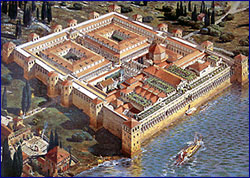
Diocletian’s palace is one of the best preserved monuments of Roman architecture in the world. Cesar's palace was built as an appropriate interpolation of various contents of a luxury villa – a summer residence, resembling a scheme of a Roman military camp (castrum), divided into four parts by two main streets. In that design, the southern end of the palace was foreseen for the emperor, his residence and fitting national and religious ceremonials, while the northern part was for the emperor's guards – army, servants, storage space and similar.
The palace is rectangular in shape (around 215 x 180 m) with four large towers at the corners, four doors on each side and four smaller towers on the walls. The lower part of the walls is without any openings, while the upper storey is thrown open with a monumental arcade in the southern part and hallways with large arching windows on the other three sides. During the centuries, the Palace's residents, and then the residents of Split as well, adapted those spaces for their needs, such that the inside of the buildings, as well as the exterior walls with towers, were largely altered from their original appearance
| top |

It is believed that this city was already established by the 4th century before Christ and that it was under strong influence of the Greek colonies, but, only with the coming of the Romans in the 1st century did the city develop and expand. It became an important port, a political, military and trade centre. Temples, thermal spas, a forum, amphitheatre, squares, storage houses, public and residential buildings were constructed. In the battle between the Cesar and Pompeii, the town took Cesar's side, who eventually won the war. As a sign of his gratitude, he promoted it to a colony – “Colonia Martia Julia Salona”.
Salona was an important centre, which draws many to come here and find their place under the sun. One of them was Gaj Aurelie Valerie Diocletian, the Roman emperor himself. He is said to have originated from a Patrician family from this region. Before the end of his life, he wished for a palace to be built for him and decided to do it on the peninsula next to Salona, in a natural cove that faces south. It has also been stated that the Cesar had arthritis, and as there were sulphurous springs there, beneficial to his emperor’s bones, the order came: “Build me a palace!”. That is how history of Split begun.

The town of Solin played an important role in Croatia’s history as the crowning town of Croatian rulers. Its importance is also demonstrated by the numerous monuments from that era, such as the Šuplja crkva (Hollow church), ruins of a castle, treasuries and the findings on the Gospin otok (The Island of Our Lady), where diggings near the present day Solin Parish Church revealed the foundations of churches from the 10th century, along with the grave of Queen Jelena.
| top |

Trogir is a small town, port and summer resort, located in the Split-Dalmatian County. The town itself is situated on a small island in the strait between the Island of Ciovo and the mainland with which it is connected by two bridges.
Trogir has a long and a tumultuous history. The wealth of its archaeological findings show an uninterrupted continuity of habitation from prehistory to today; there are traces of life in this area dating from the year 2000 B.C. The ancient Greeks founded a colony called Tragurion on the foundations of an older Illyrian settlement during the 3rd/2nd century B.C. The marble relief showing Kairos, a divine figure, dates from that time (4th/3rd century B.C.). During the 1st century B.C., this Illyrian-Greek settlement became a Roman municipality, called Tragurium, and was renowned for its stone.
Trogir is one of the rare Dalmatian towns that managed to escape interruptions to its urban life continuity, unlike the adjacent town of Salona, which was run down during the Avarian and Slavic invasions at the beginning of the 7th century. Trogir extended its continuity within Dalmatia under the Byzantine rule. The town was then inhabited by Croats; Croatian dukes founded their estates in Bijaci and built the Church of St. Martha. On the antique landscape of the town, on the foundations of early-Christian churches, early-medieval churches were built, adorned with ancient Croatian wicker ornaments, as well as numerous early-medieval houses.
The historical core of Trogir is a unique monument of culture, and was therefore included in UNESCO's World Heritage List in 1997. The urban and architectural plan of Trogir has kept its basic medieval structural elements of a fortified town, the typical composition of streets and squares, the representative sacral and secular public facilities and a condensed myriad of other buildings. Regardless of the architectural value of some of its specific facilities, Trogir is most of all, remarkably valuable as a whole, with its many messages - artistic, cultural-historical and represents one of the most important cultural assets in Croatia, as well as the whole world.
| top |

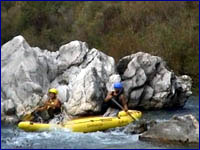
The Krka National Park is a spacious, largely unchanged region of exceptional and multifaceted natural value, and includes one or more preserved or insignificantly altered ecosystems.
It is intended primarily for scientific, cultural, educational, recreational, and tourism activities such as visiting and sightseeing.It was proclaimed a national park in 1985 and is the seventh national park in Croatia.
The Krka National Park is located entirely within the territory of Šibnik-Knin County and encompasses an area of 109 square kilometers along the Krka River: two kilometers ownriver from Knin to Skradin and the lower part of the Cikola River. From the flooded part of the mouth, it is 72.5 kilometers in length, making the Krka the 22nd longest river in Croatia.
The source of the Krka River is at the base of the Dinaric Mountains, 3.5 kilometers northeast of the base of Knin and 22 meters below Topoljski Slap, Veliki Buk and Krcic Slap, which are noisy cascades in the winter but run dry during the summer.
The length of the freshwater section of the river is 49 kilometers and that of the brackish section is 23.5 kilometers. Significant tributaries of the Krka River include Krcic, Kosovcica, Orašnica, Butišnica and Cikola with Vrb.With its seven travertine waterfalls and a total drop of 242 meters, the Krka River is a natural and karstic phenomenon.
| top |

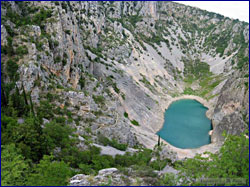
Imotski, the central settlement in the wide Imotska Krajina, important cross-roads and small picturesque town near the fertile Imotsko Field. Historians have found that Imotski existed in the times of Ilirians and Romans, and it is first mentioned by the Byzantine Emperor Constantin Porfirogent in the 10th century. The prehistoric mounds and Roman graves have been found in the vicinity. In the medieval historical sources it was mentioned as important fortress. On the hill above the town there are the ruins of the old fortress.
| top |

Dubrovnik was founded in the 7th century. Town walls 2 km long, which were built in the period from the 11th to the 17th century, surround it. Throughout the history Dubrovnik has attracted and fascinated with its beauty many inquisitive persons, travel writers, adventurers, and many others as it still does today.
The main street in Dubrovnik, Stradun, is unique in its beauty; it is the center of the ancient town core and the favorite gathering point of the inhabitants.
Dubrovnik, with its 17 monasteries and churches and one of the oldest synagogues in Europe, represents a cultural heritage monument and is protected by UNESCO.
| top |